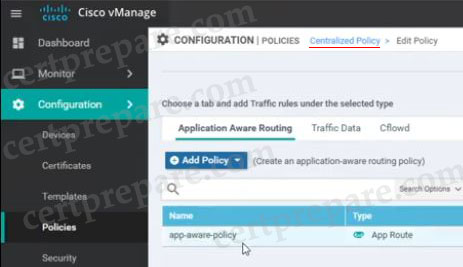Policy & QoS Questions
Cisco SD-WAN architecture implements two types of data policy:
+ Centralized data policy: policy that is configured on a Cisco vSmart Controller (hence, it is centralized) and that affects data traffic being transmitted between the routers on the Cisco SD-WAN overlay network. They affect traffic flow across the entire network.
+ Localized data policy controls the flow of data traffic into and out of interfaces and interface queues on a Cisco vEdge device. It is provisioned locally on the Cisco vEdge device, using access lists. It allows you to classify traffic and map different classes to different queues. It also allows you to mirror traffic and to police the rate at which data traffic is transmitted and received.
Question 1
Explanation
In the exhibit above, the “policer ccnp” is configured to have a maximum traffic rate of 1,000,000 bits per second and a maximum burst-size limit of 15000 bytes. Traffic exceeding these rate limits is dropped.
The policer is then included in the access list “acl-guest”, which is configured to accept all TCP traffic (protocol 6) originating from the host at source 172.16.10.0/24 and going to the destination host at 172.16.20.0/24 on port 20. All other traffic is dropped (default-action-drop) -> Therefore answer C is correct (as all UDP traffic is dropped).
Question 2
Question 3
Explanation
When traffic exceeds 20 MB (configured in the policer burst command), we change the Packet Loss Priority (PLP) from low to high (configured by the policer exceed remark command).
exceed is the action to take when the burst size or traffic rate is exceeded. action can be drop (the default) or remark. The drop action is equivalent to setting the packet loss priority (PLP) bit to low. The remark action sets the PLP bit to high.
Question 4
Explanation
The “Application Aware Routing” policy is created under “Centralized Policy”.

Question 5
Question 6
Question 7
Explanation
Centralized data policy: policy that is configured on a Cisco vSmart Controller (hence, it is centralized) and that affects data traffic being transmitted between the routers on the Cisco SD-WAN overlay network. They affect traffic flow across the entire network. This will also help in controlling to send specific application traffic over specific tunnel based on jitter, delay, latency.



Q7 is central data policy
@viptelaguy: Thanks for your detection, we have just updated it!
what is the Q7?
@certprepare: Is there any new questions after September 10th, 2020 ?
Q7 answer should be (A). QoS policies are set using Localized Data Policies.
@Cert2021: But the question is related to AAR which is centralized Data Policy. So in my opinion the given option “D” is correct.
Q7 is correct – Answer is D
“An application-aware routing policy is a type of centralized data policy” https://www.cisco.com/c/dam/en/us/td/docs/routers/sdwan/configuration/config-18-2.pdf#page=387
Q3 is wrong in so many ways. It’s from an official example which is also wrong.
https://sdwan-docs.cisco.com/Product_Documentation/Software_Features/SD-WAN_Release_17.1/08Forwarding_and_QoS/03Forwarding_and_QoS_Configuration_Examples
Rate should be in bit/s so it’s 10000000 for 10 Megs and not 1000000.
Burst should be in bytes so 20000 is for 20 Kbytes and nothing sets 20 Mbps burst limit.
Also the redirection of the traffic is done by another policy (see the end of the page on the link above).